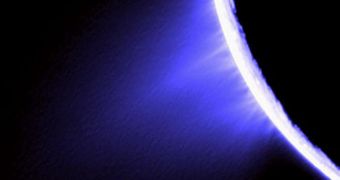Experts at the American space agency announced that their Cassini space probe had just carried out a new flyby of the Saturnine moon Enceladus, one of the most interesting bodies in our solar system.
The natural satellite is covered by a thick layer of ice, underneath which planetary scientists believe a liquid ocean exists. Motions in this body of water may be what drive the jet plumes that can be observed at the south pole of Enceladus.
The region contains a variety of tiger stripe-like features, which are in fact deep lacerations in the ice, which allow the space object's interior to communicate with the outside world.
Past investigations carried out using the NASA orbiter have demonstrated that water vapors and organic molecules are spewing out of the geysers, which means that alien life could indeed exist beneath the thick, icy crust.
Recent flybys conducted around the moon sought to gain more insight into its internal structure. This was done by turning off most of Cassini's instruments, except for the radio data analysis suites.
As the probe passed around the natural satellite, slight variations in the body's magnetic pull allowed the probe to compile a map of how matter is distributed in its interior.
But those investigations were not extensive enough to allow experts to say for sure that a liquid ocean roams beneath the crust, driving plumes of ice upwards, and fueling the geysers.
This is why NASA carried out a new flyby of the Saturnine moon yesterday, December 20. The probe flew to within 48 kilometers, or 30 miles, of the satellite's surface, say experts at the Jet Propulsion Laboratory (JPL).
The point of closest approach was reached at 8:08 pm EST on December 20 (0108 UTC, Dec. 21), the team goes on to say. The JPL manages Cassini for the NASA Science Mission Directorate in Washington DC.
“Cassini's fields and particles instruments will get priority during this flyby,” said JPL scientists before yesterday's flight.
“They will be trying to characterize the particles that may form a tenuous atmosphere around Enceladus and see if they may be similar to the faint oxygen- and carbon-dioxide atmosphere detected recently around Rhea, another Saturnine moon,” they added.
This 13th flight that Cassini carried out around Enceladus is aimed at studying the moon's northern hemisphere, which may hold some interesting discoveries in itself, experts say.
Details of the most recent flyby are expected to be made available within a few days.

 14 DAY TRIAL //
14 DAY TRIAL //